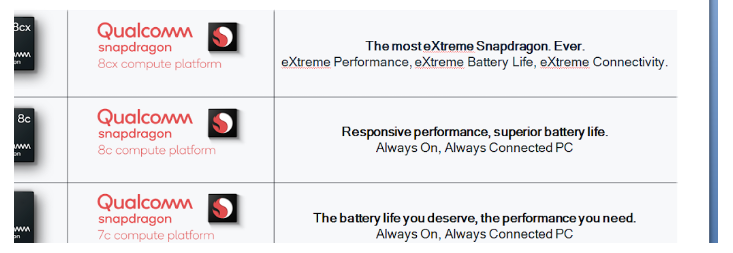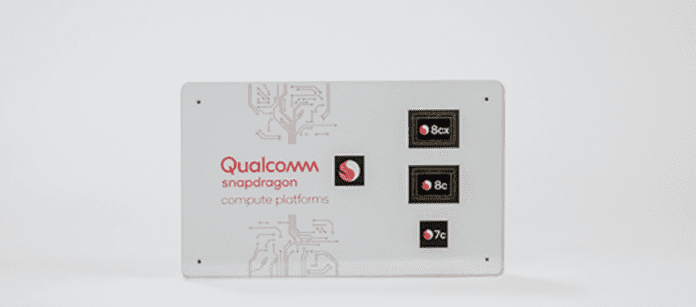Qualcomm, during its annual Tech Summit in Maui, Hawaii, unveiled a comprehensive portfolio of platforms for Always-On, Always-Connected PCs (ACPCs) to cover the full spectrum of tiers and use cases. This announcement further solidifies the industry’s move toward ACPCs, led by Qualcomm, Microsoft, and Arm.
<<Side note – If you would like to know more about ACPCs, please check out my earlier articles here, here and here. >>
A broad portfolio of offerings
The Snapdragon 8cx, announced at the same event last year, was the first real ACPC platform that brought Arm chips into the performance and enterprise computing space. Since then, the 8cx has powered a handful of devices, including trend-setting Microsoft Surface Pro X, stylish Samsung Galaxy Book S, and the first 5G supported Lenovo ACPC. Many other designs are in the pipeline.
While the Snapdragon 8cx was targeted at the premium and high-performance segment, the newly announced Snapdragon 8c and Snapdragon 7c offer OEMs the choice to address to the other tiers in the highly competitive laptop space. The tiering is based on CPU, GPU, and DSP performance, Artificial Intelligence (AI), and Machine Learning (ML) capabilities, and cellular connectivity speeds. However, Qualcomm never forgets to emphasize that even with tiering, all the platforms squarely deliver on the ACPCs famed promise of smartphone-like ultra-thin form-factor, multiday battery life, and excellent connectivity, without any compromises. This promise is attractive for any tier, and that’s why almost every major PC OEM has embraced ACPCs.

Snapdragon 8c for everyday laptops
The key aspect of Snapdragon 8c is enabling sub-$800, highly capable, consumer, and enterprise ACPCs that excel in high productivity workloads, as well as top-notch entertainment and multimedia performance. The 8c is a beast sporting a 7nm octa-core Kryo 490 CPU, Adreno 675 GPU, 4-channel LPDDR4x memory, support for NVMe SSD, and UFS 3.0, dedicated Hexagon AI/ML Tensor Accelerator, integrated Snapdragon X24 LTE modem, and many other impressive features.
Snapdragon 8c offers 30% higher system performance than its predecessor—Snapdragon 850, more than 6 Trillion Operations Per Second (TOPS) AI/ML, and up to 2 Gbps of cellular speed.
You can get more detailed specifications of this platform here.
Snapdragon 7c for entry-level ACPCs
The primary focus of Snapdragon 7c is to bring the ACPC experience to even the cost-conscious entry-level laptops. These laptops are highly functional, with a sub-$400 price point. The 7c sports 8nm octa-core Kryo 468 CPU, Adreno 618 GPU, 2-channel LPDDR4x memory, robust AI/ML support unheard of at this tier, and integrated Snapdragon X15 LTE modem, among other things.
It offers 25% higher performance than competing solutions in the entry tier, more than 5 TOPS AI/ML, and up to 800 Mbps of cellular speed.
You can get the detailed specifications of this platform here.
Busting the myths of portability
Till now, portability in computing always meant a complex trade-off between weight and size, performance, battery life, and cost. If you wanted a thin and portable computing device, the only option was to use a tablet and be content with limited performance and crippled functionality, without the support for productivity OS such as Windows 10. On the other hand, if you wanted robust performance and long battery life, you had to cope with large and bulky devices with extended battery packs. If you wanted a combination of these features, you had to be ready for a hefty price tag.
But with ACPCs, you get uncompromised experience without any tradeoffs— Arm architecture that offers superior battery life and performance, full Windows 10 support for unhindered productivity, integrated cellular modem for always-on connectivity. All of that together in a thin, light-weight, and very attractive form factors, just like your smartphone.
The ACPCs are essentially aligning the computing industry with the smartphone industry. That will bring the smartphone industry’s hallmark of rapid innovation to the computing industry. Together both will benefit from the large economies of scale, cost-efficiency, and a huge ecosystem of OEMs, app developers, consumers, and enterprise players. That, in turn, has the potential to revitalize the stagnant and uninteresting laptop market and bring it much needed excitement and growth.
In other words, ACPCs are set to challenge the status quo of Intel’s x86 architecture and revolutionize the laptop/personal computing market.
In closing
Qualcomm’s announcement expanding the reach of ACPCs illustrates how the “Windows on Snapdragon” concept that Qualcomm, Microsoft, and Arm envisioned a few years ago is slowly but steadily coming to fruition. The comprehensive portfolio of platforms will pave the way for making ACPCs mainstream, bringing their benefits to all market segments, not just for the premium tier.
It will be interesting to see how the tussle between deeply rooted traditional x86 architecture and the disruptive Arm architecture unfolds and shapes the laptops and personal computing space.

